LANKE XUNTONG TECHNOLOGY PTR9618 Bluetooth low energy 4.0 modules User Manual
LANKE XUNTONG TECHNOLOGY CO.,LTD Bluetooth low energy 4.0 modules Users Manual
Contents
- 1. User Manual
- 2. Users Manual
User Manual
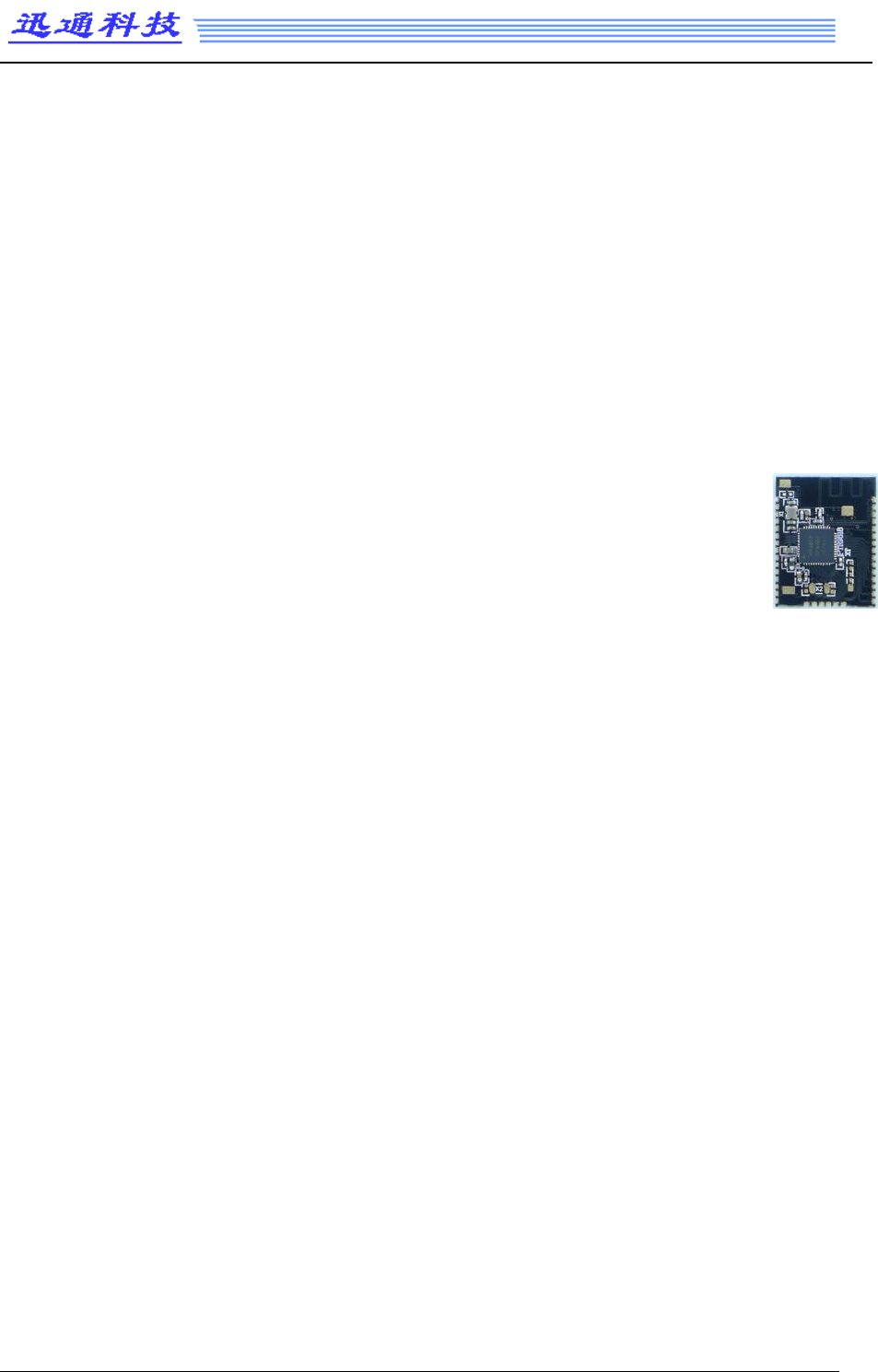
Bluetooth Low Energy 4.0 Module
Embedded Cortex™ M4F 32 bit processor
The PTR9618 ultra-low power Bluetooth Low Energy/ANT/2.4GHz Proprietary
Multi-protocol modules based on the nRF52832 from Nordic Semiconductor. The module
with an ARM® Cortex™ M4F 32 bit processor, embedded 2.4GHz transceiver, and
integrated antenna, provide a complete solution with no additional RF design, allowing
faster time to market, while simplifying designs, reducing BOM costs, also reduce the
burden of Regulatory approvals to enter the world market. Making you more quickly into
the bluetooth smart application and remove the worries.
Features
System on Module(SOM) base on Nordic nRF52832
Bluetooth Low Energy/ANT/2.4GHz Proprietary Multi-protocol support
Complete Bluetooth Low Energy stack/profiles solution (Bluetooth 4.x and Higher)
ARM® Cortex™-M4F 32 bit processor, 512 kB flash memory, 64 kB RAM
32 General Purpose I/O, Configurable mapping Pins, Simple layout of external application
12-bit/200KSPS ADC
Three SPI Master/Slave (8 Mbps)
Low power comparator, Temperature sensor, Random Number Generator
Two 2-wire Master/Slave (I2C compatible)
I2S audio interface, PDM audio interface
UART (w/ CTS/RTS and DMA)
3x4-channel PWMs
20 channel CPU independent Programmable Peripheral Interconnect (PPI)
Quadrature Demodulator (QDEC)
128-bit AES HW encryption
5 x 32bit Timers, 3 x 24bit Real Timer Counters (RTC), Watchdog Timer
NFC-A tag interface for OOB pairing
Internal RC Oscillator 32.768 kHz(± 250 ppm).
No external components required
Over-the-Air (OTA) firmware updates available
Dimensions: 22.7mmx17.5mm x1.8mm with Antenna,1.27mm pin pitch.
PTR9618
COPYRIGHT ©2017 ALL RIGHTS RESERVED XunTong Tech TEL: +86 755 26675941 E-mail: nrf@freqchina.com
1
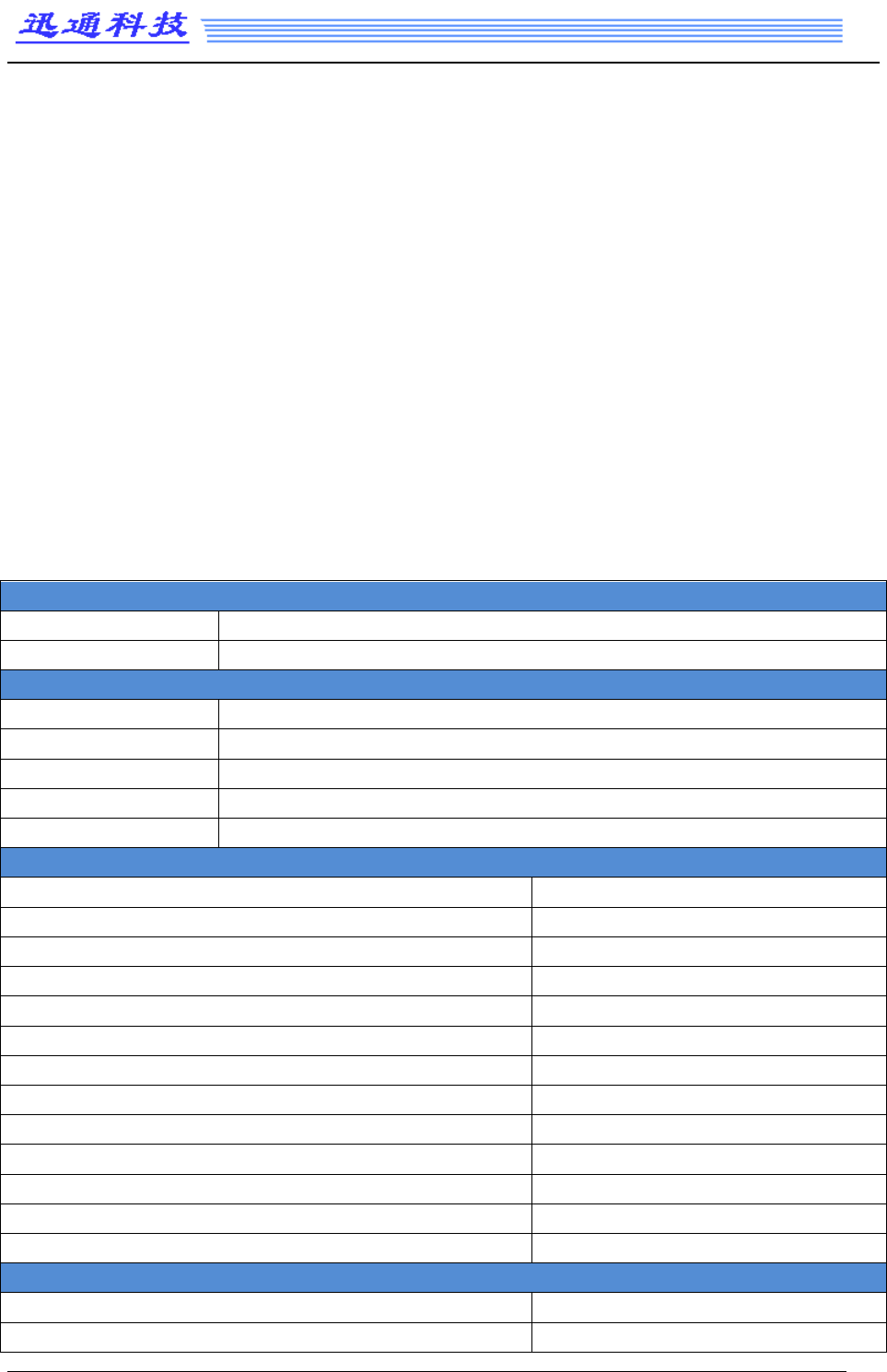
Typical Applications:
- 2.4 GHz Bluetooth low energy systems
- Proprietary 2.4 GHz systems
- Sports and leisure equipment
- Mobile phone accessories, Connected Appliances
- Health Care and Medical
- Consumer Electronics, Game pads
- Human Interface Devices, Remote control
- Building environment control / monitoring
- RFID, Security Applications,Low-Power Sensors
- Bluetooth Low Energy GateWay
- iBeacons™, Eddystone™, Indoor navigation
- Lighting Products
- Fitness devices, Wearables
Quick Specifications:
Multi-protocol
Version Bluetooth 4.0 /ANT/2.4GHz Proprietar
Security
AES-128
Radio
Frequency
2.402GHz to 2.480GHz
Modulations
GFSK at 1 Mbps, 2 Mbps data rates
Transmit power +4 dBm
Receiver sensitivity -96 dBm (BLE mode)
Antenna Integrated
Current Consumption
TX only @ +4 dBm, @ 3V, DC/DC enabled 7.5 mA
TX only @ 0 dBm, @ 3V, DC/DC enabled 5.3 mA
TX only @ +4 dBm
16.6 mA
TX only @ 0 dBm
11.6 mA
RX only @ 1 Mbps @ 3V, DC/DC enabled
5.4 mA
RX only @ 1 Mbps
11.7 mA
CPU @ 64MHz from flash
7.5 mA
CPU @ 64MHz from RAM 6.7 mA
CPU @ 64MHz from flash @ 3V, DC/DC 3.7 mA
CPU @ 64MHz from flash RAM @ 3V, DC/DC 3.3 mA
System On 1.2 μA
System Off 0.7μA
Additional current for RAM retention 20 nA / 4K block
Operating conditions
Power supply
1.7~3.6V
Operating temperature
-25~+85 °C
COPYRIGHT ©2017 ALL RIGHTS RESERVED XunTong Tech TEL: +86 755 26675941 E-mail: nrf@freqchina.com 2
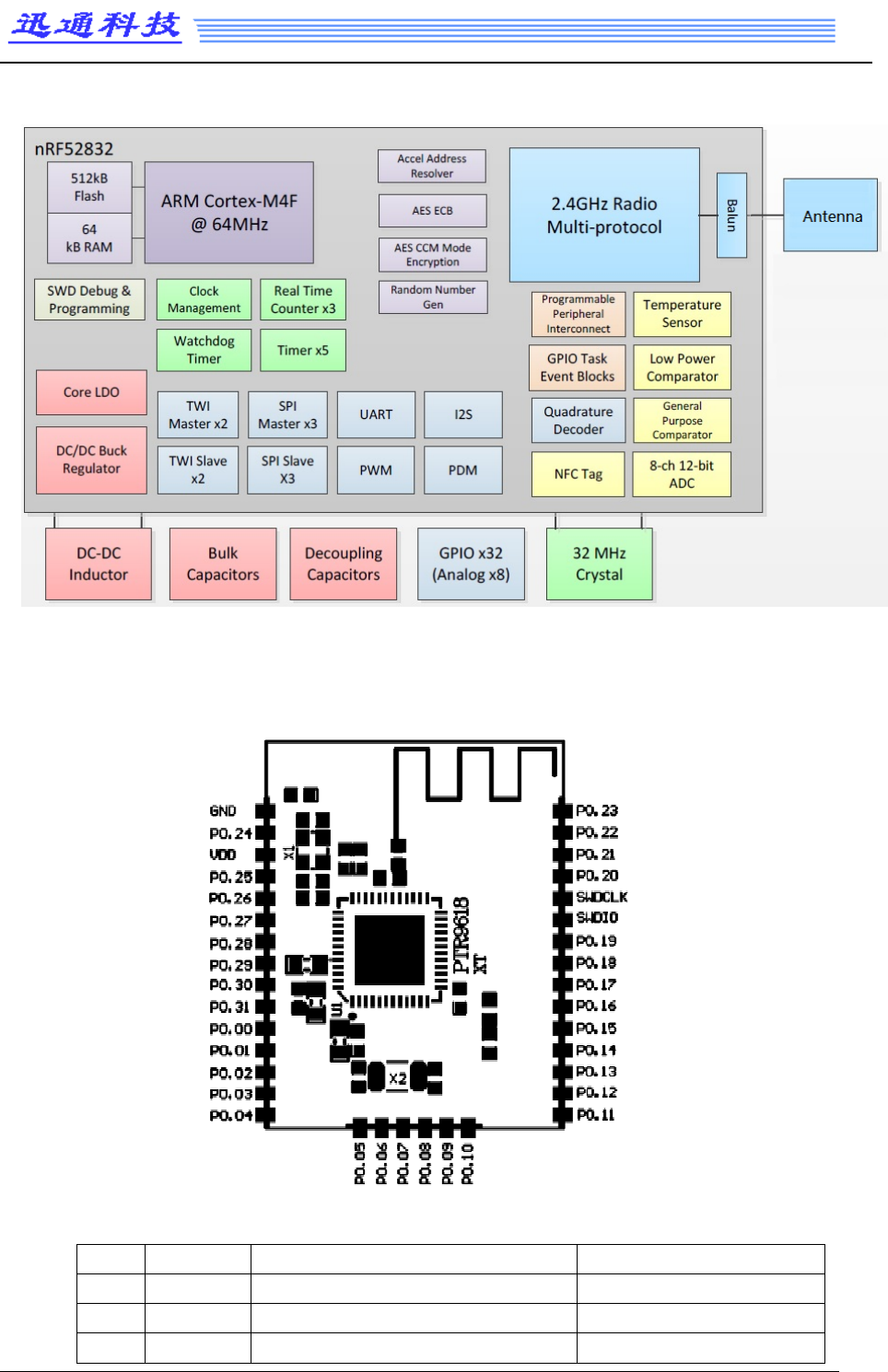
Block diagram:
Pin Description of Module
(
Top View
)
:
Pin Name Description Note
Pin1 P0.23 Digital I/O
Pin2
P0.22
Digital I/O
Pin3
P0.21
Digital I/O
Configurable as pin reset.
COPYRIGHT ©2017 ALL RIGHTS RESERVED XunTong Tech TEL: +86 755 26675941 E-mail: nrf@freqchina.com
3

Pin4
P0.20
Digital I/O
Pin5 SWDCLK HW debug and flash programming I/O
Pin6
SWDIO
HW debug and flash programming I/O
Pin7
P0.19
Digital I/O
Pin8 P0.18 Digital I/O
Pin9 P0.17 Digital I/O
Pin10 P0.16 Digital I/O
Pin11 P0.15 Digital I/O
Pin12 P0.14 Digital I/O
Pin13 P0.13 Digital I/O
Pin14
P0.12
Digital I/O
Pin15
P0.11
Digital I/O
Pin16
P0.10
Digital I/O
Pin17
P0.09
Digital I/O
Pin18 P0.08 Digital I/O
Pin19 P0.07 Digital I/O
Pin20 P0.06 Digital I/O
Pin21 P0.05 Digital I/O
Pin22 P0.04 Digital I/O
Pin23 P0.03 Digital I/O
Pin24
P0.02
Digital I/O
Pin25 P0.01 Digital I/O
Pin26 P0.00 Digital I/O
Pin27
P0.31
Digital I/O
Pin28 P0.30 Digital I/O
Pin29 P0.29 Digital I/O
Pin30 P0.28 Digital I/O
Pin31 P0.27 Digital I/O
Pin32 P0.26 Digital I/O
Pin33 P0.25 Digital I/O
Pin34
VCC
Power Supply
Pin35 P0.24 Digital I/O
Pin36
GND
Ground
Note: An internal 4.7μF bulk capacitor has been included on the module. For those application that
with heavy GPIO usage and/or current draw, it is good design practice to add additional bulk
capacitance as required for your application.
General Purpose I/O:
The general purpose I/O is organized as one port enabling access and control of the 32 available
GPIO pins through one port. Each GPIO can be accessed individually with the following user
configurable features:
Input/output direction
Output drive strength
COPYRIGHT ©2017 ALL RIGHTS RESERVED XunTong Tech TEL: +86 755 26675941 E-mail: nrf@freqchina.com
4
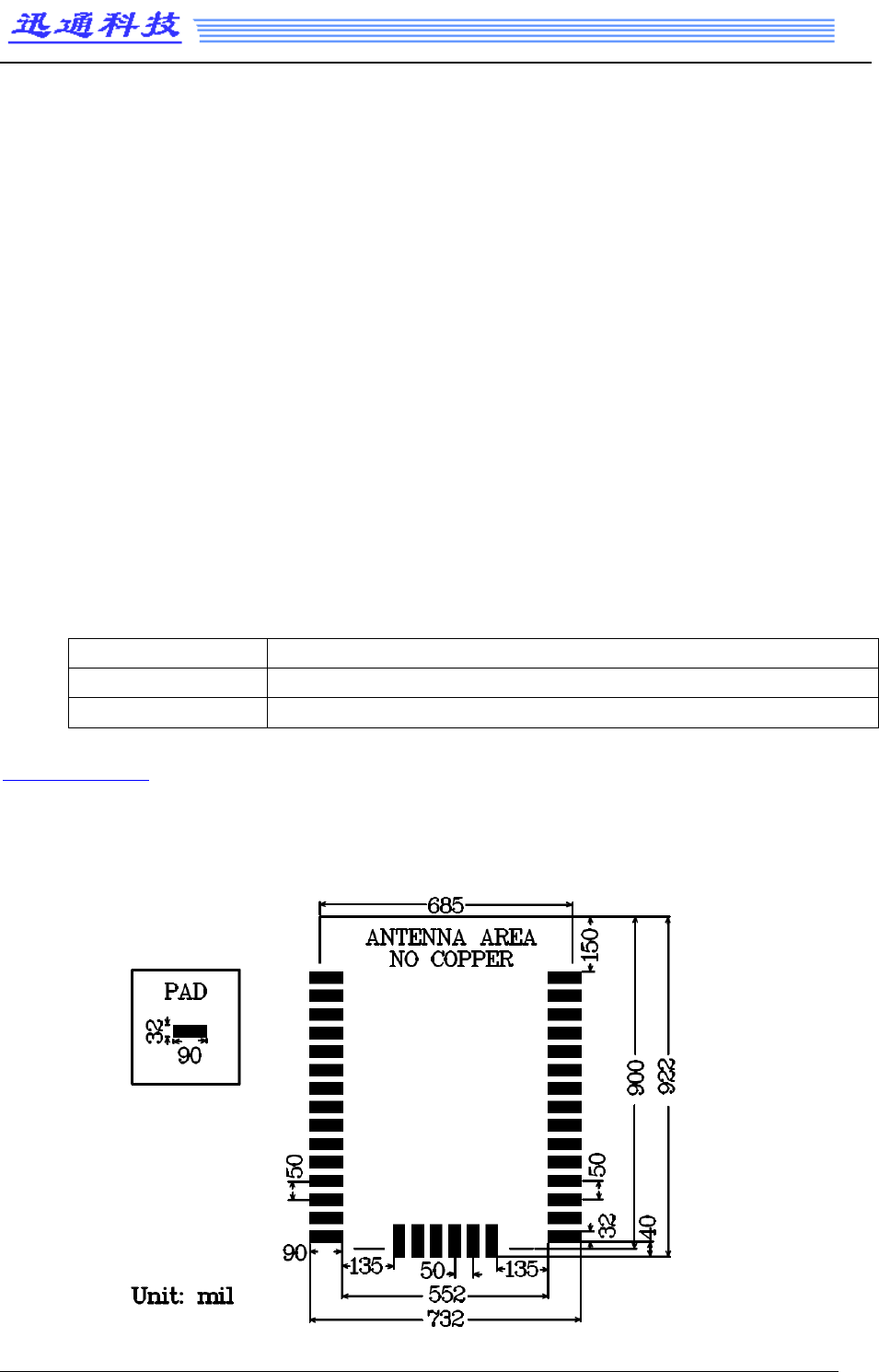
Internal pull-up and pull-down resistors
Wake-up from high or low level triggers on all pins
Trigger interrupt on all pins
All pins can be used by the PPI task/event system; the maximum number of pins that can be
interfaced through the PPI at the same time is limited by the number of GPIOTE channels
All pins can be individually configured to carry serial interface or quadrature demodulator
signals
Hardware RESET:
There is on-chip power-on reset circuitry, But can still be used in external reset mode, in this case,
GPIO pin P0.21 as an external hardware reset pin. In order to utilize P0.21 as a hardware reset, the
UICR registers PSELRESET[0] and PSELRESET[1] must be set alike, to the value of 0x7FFFFF15.
When P0.21 is programmed as RESET, the internal pull-up is automatically enabled.
HW debug and flash programming of Module :
The Module support the two pin Serial Wire Debug (SWD) interface and offers flexible and powerful
mechanism for non-intrusive debugging of program code. Breakpoints, single stepping, and
instruction trace capture of code execution flow are part of this support.
Pin
Flash Program interface
SWDIO
Debug and flash programming I/O
SWCLK
Debug and flash programming I/O
This is the hardware debug and flash programming of module, J-Link Lite support, please refer
www.segger.com.
PCB Footprint
(
Top View
)
:
COPYRIGHT ©2017 ALL RIGHTS RESERVED XunTong Tech TEL: +86 755 26675941 E-mail: nrf@freqchina.com
5
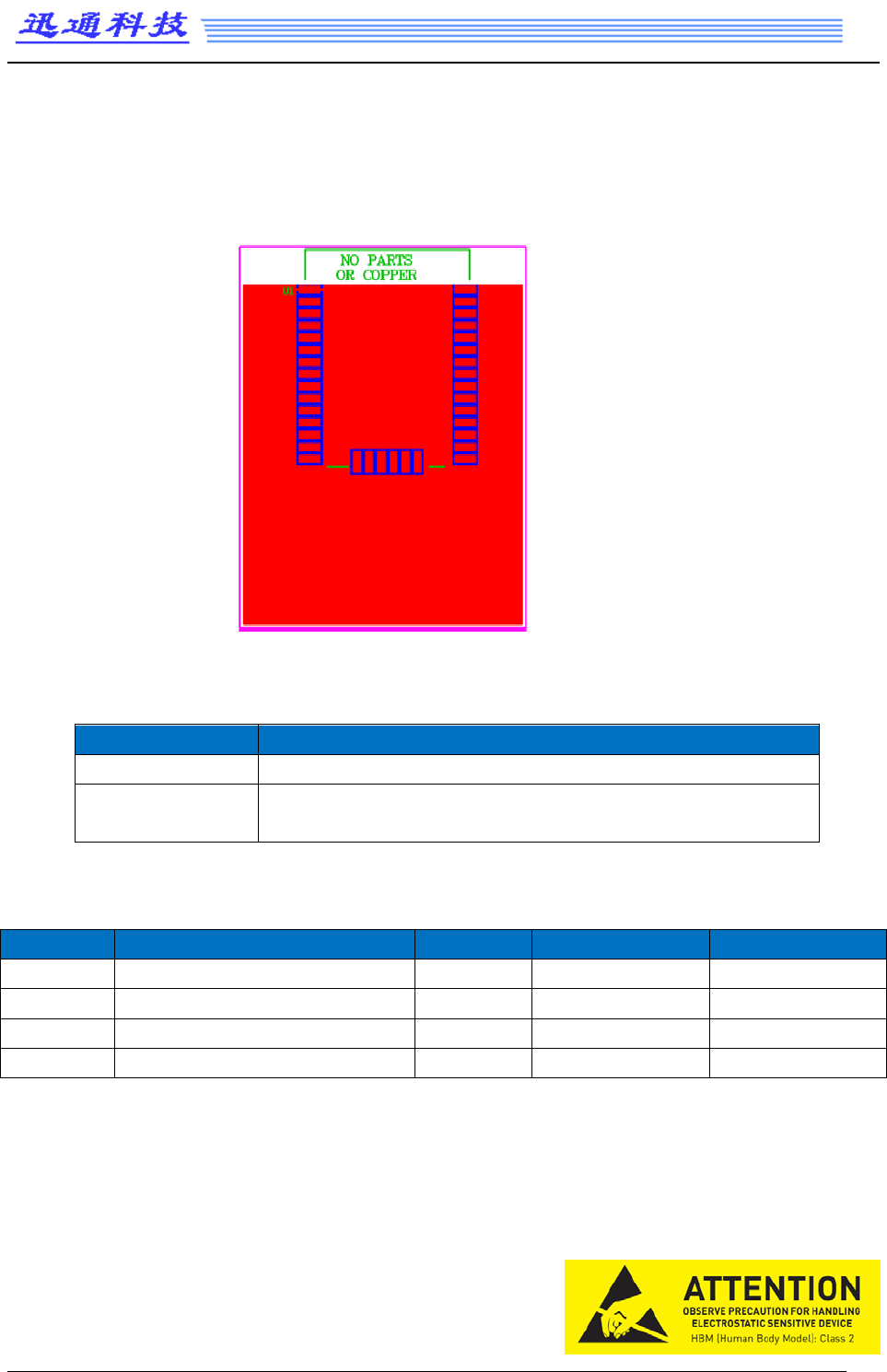
Recommended RF Layout & Ground Plane:
The module integrated antenna requires a suitable ground plane to radiate effectively. The area
under and extending out from the antenna portion of the module should be kept clear of copper and
other metal. The module should be placed at the edge of the PCB with the antenna edge facing out.
Reducing the ground plane will reduce the effective radiated power.
Ordering Information:
Part Number
Description
PTR9618 Bluetooth Low Energy System on Module
PTR9618-EVB
Evaluation boards for module,with key, LED, I/O extend,sock
for coin cell battery.
Absolute Maximum Ratings:
Symbol
Parameter
Min.
Max.
Unit
V
CC_MAX
Voltage on supply pin
-0.3
3.9
V
V
IO_MAX
Voltage on GPIO pins (V
CC
> 3.6V)
-0.3
3.9
V
V
IO_MAX
Voltage on GPIO pins (V
CC
≤ 3.6V)
-0.3
V
CC
+ 0.3V
V
TS Storage Temperature Range -40 125 °C
Important Notice:
Reserves the right to make corrections, modifications, and/or improvements to the product and/or
its specifications at any time without notice.
Assumes no liability for the user’s product and/or applications.
Products are not authorized for use in safety-critical applications, including but not limited to
life-support applications.
ATTENTION!
Electrostatic Sensitive Device
Observe Precaution for handling.
COPYRIGHT ©2017 ALL RIGHTS RESERVED XunTong Tech TEL: +86 755 26675941 E-mail: nrf@freqchina.com
6